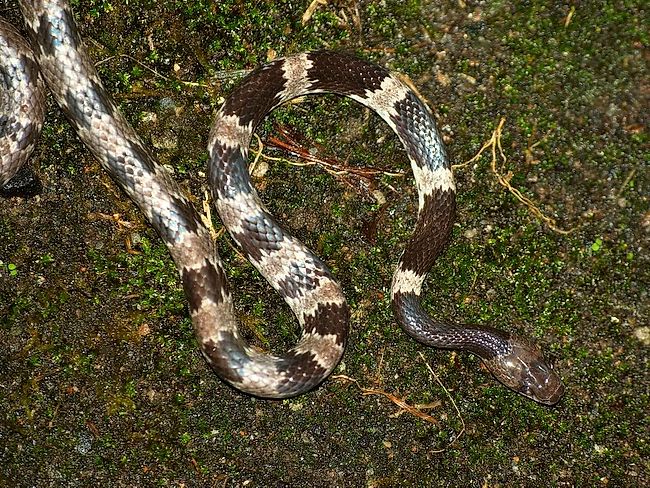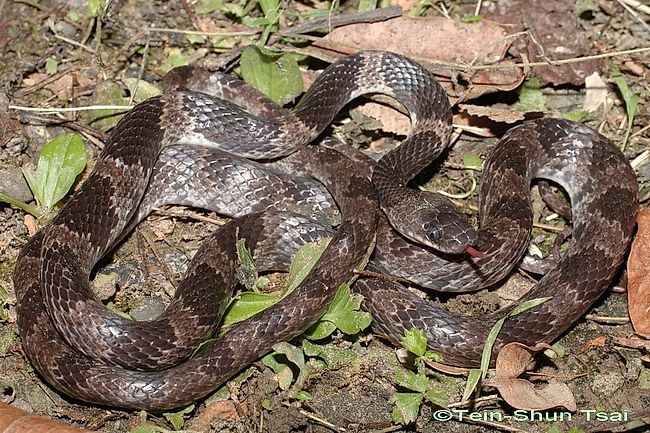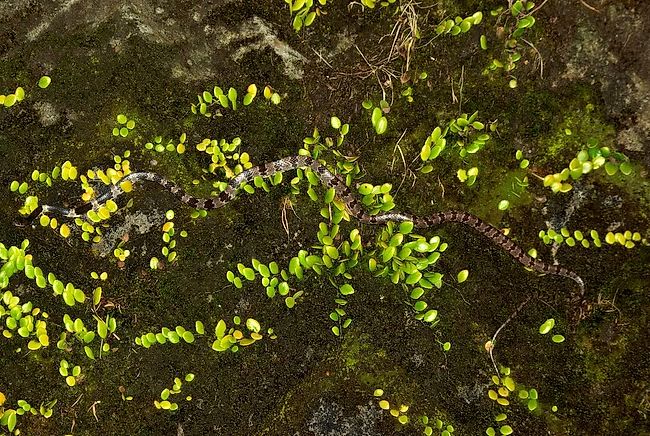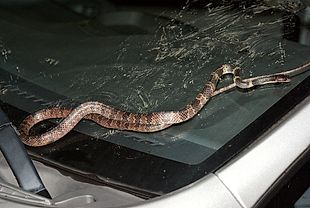Lycodon ruhstrati ruhstrati
Formosa Wolf Snake, White Plum Blossom Snake
白梅花蛇 (bai2mei2hua1she2)
Status: Not Protected
Non-venomous
Family
Colubridae, subfamily Lycodontinae
Max. length
110 cm
Occurrence in Taiwan
Throughout Taiwan, up to 1000 m altitude. Quite common.
Global Distribution
Central/South China (Jiangxi, Fujian, Guangdong, Guangxi, Anhui, Sichuan, SE Gansu, Jiangxi, Jiangsu, Guizhou, Hunan, Shaanxi, Zhejiang), Taiwan, Japan (S. Ryukyu islands), Vietnam.
Description
Medium-sized snake; total length up to 110 cm. There are 15-19 (17 at mid-body) rows of scales, which are feebly keeled except those on the flanks. Head is oval, with snout protruding over the mental; body is slender; tail is long and very slender. Eye is medium-sized, near top of head, and bulging laterally; iris is dark gray to black and pupil is black, broadly elliptical on vertical axis. Tongue is flesh-colored, with fork tips tinged with gray. Upper head is usually dark gray to black but may have indistinct broad band of gray (or distinct white band in juveniles) across back of head. The lower two-thirds of the supralabials are light gray to white. Upper body and tail are white to gray, usually with irregular black crossbars which may show margins of white. The crossbars are broad and distinct anteriorly, and progressively narrower and less distinct posteriorly. Bands of body and tail tend to be more distinct in juveniles. Ventral head and neck are dirty white to light gray, sometimes with diffuse black pigment on mental and inner margins of lower labials. Ventral body is dirty white to light gray with scattered spots of diffuse gray brown pigment which increases progressively toward posterior half of body. Underside of tail is mottled, dark gray, occasionally with faint cross bands continuous from upper tail. Anal scale is single and subcaudals are paired.
Biology & Ecology
This nocturnal, oviparous snake leads a terrestrial as well as arboreal lifestyle in mountainous areas and plantations. It preys on lizards and insects. The genus name Lycodon, meaning "Wolf Tooth", hints at the snake's front teeth, which are much larger than the ones in the rear, and which its owner uses to catch said lizards. L. r. ruhstrati is a fast, twitchy hunter with quite a nervous disposition and a penchant for random biting. "The defensive behavior of the Formosa Wolf Snake includes a triple-looped neck display, bluff-srtiking, struggling/thrashing, tail rattling and biting." (Source video)
Etymology
Lycodon: lycos is Greek for "wolf", odon means "tooth"; a reference to the animal's front teeth, which are much larger than the ones in the rear, and with which the snake catches fast lizards.
ruhstrati: named after German customs officer Ernst K. A. Ruhstrat, who collected the type specimens in southern Taiwan for the Oldenburg Museum.
The Chinese name 白梅花蛇 (bai2mei2hua1she2) literally means "White Plum Blossom Snake".
Notes
Under poorly lit conditions, this nonvenomous snake looks quite similar to the Many-banded Krait (Bungarus multicinctus multicinctus) Under good lighting, though, there is no mistaking the dangerous one: The krait has sharply separated black and white bands and a triangular body cross-section, while Lycodon has additional grey-brown bands, and the borders between the rings are somewhat more muddled. However, the first two or three inches behind the head do not show these grey bands, and the head is not very distinct from the neck, not unlike B. m. multicinctus. This similarity often leads to an untimely death for the L. r. ruhstrati at the hands of frightened humans.
Further Info















































